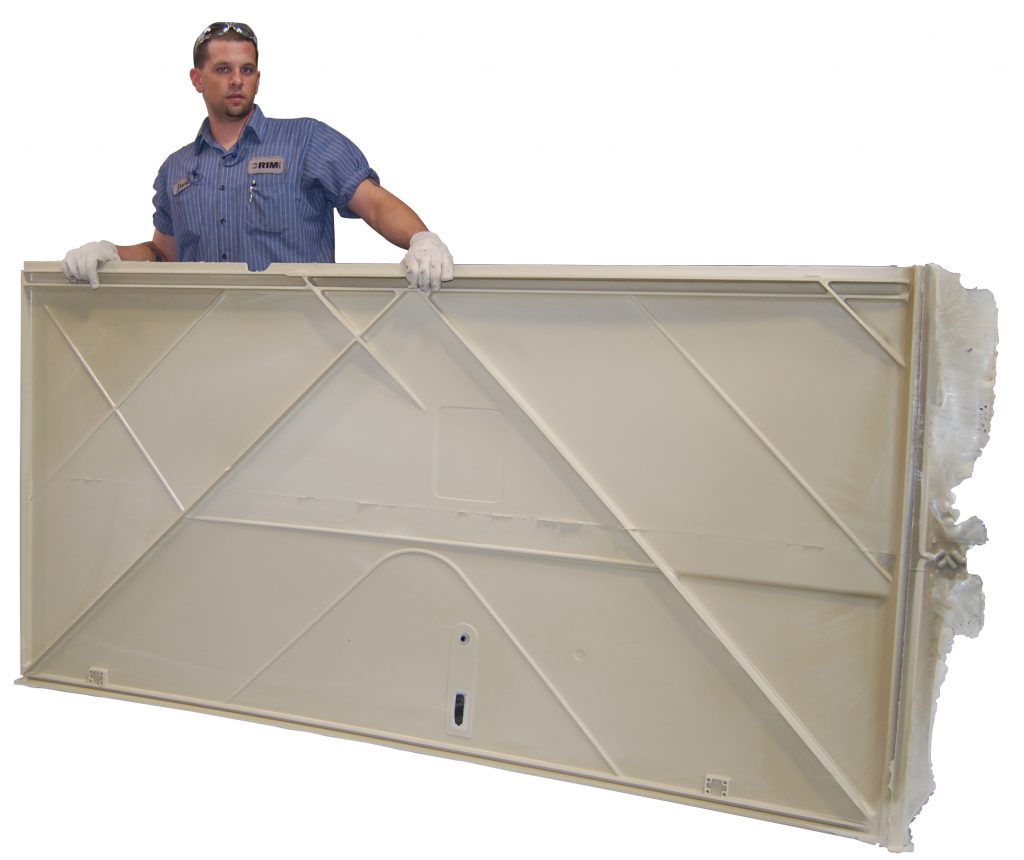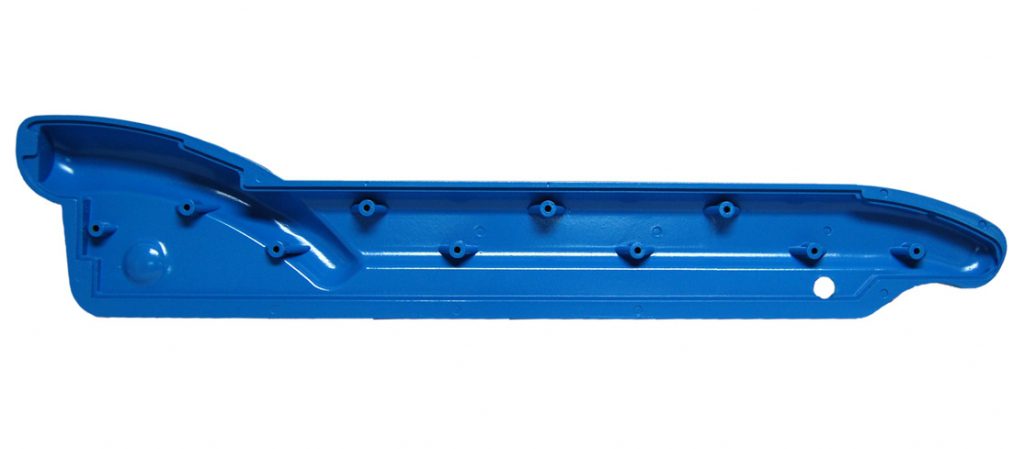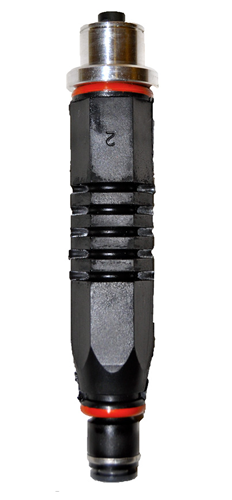RIM Design | Part Design
Get A Better Reaction to Your Design
In general, reaction injection molding (RIM) allows for superior design in polyurethane parts – over plastic injection molding, thermoforming, and cast molding – when you require:
- Low cost tooling
- Large parts
- Variable part wall thickness
- Molded in bosses, ribs, inserts, tabs or undercuts
- Flexible cosmetic surface and part design
- Encapsulation capabilities
- Dimensional stability
- Chemical resistance
- In-mold painting and post-paint

7.5’x3.5’ Rigid RIM Foam, 94V-0
Molded in Ribs, Tabs, and Bosses
RIM Design VS Thermoforming VS Plastic Injection Molding
RIM Design Advantages Over Plastic Injection Molding
- RIM design is approximately 70% less expensive for most projects
- RIM is able to mold thick yet light structural parts without any sink
- RIM design can vary wall thicknesses, even within the same usable product
- RIM has a similar tolerance to injection molding
- RIM design can be molded over metal, glass, wood, wiring, circuit boards, and hardware
- RIM has a much better economics for lower volume parts
- RIM design has a shorter tooling lead time versus plastic injection molding
Plastic Injection Molding Process Advantages
- Lower per-part cost for very high-volumes
- If using colored plastic, parts do not always need to be painted
- Finer part details available for plastic parts and molded parts
- Often a greater range of material choices
RIM Design Advantages Over Thermoforming
- Much higher freedom in RIM designs
- Much lower costs for complex parts
- Higher part tolerance
- Able to combine multiple parts
- Molded-in bosses, ribs and other 3D-features
- Thicker and stronger part designs
Thermoforming Process Advantages
- Can be less expensive for very simple parts
- Often no paint is needed for single-color sheet plastic parts
- Generally less expensive tooling

Variable Wall Thickness with NO Sink
RIM Manufacturing Will Match the Best System for Your RIM Design
The range of polyurethane systems that reaction injection molding (RIM) allows means you can achieve your ideal characteristics of:
- Impact resistance
- Dimensional stability and strength
- Design tolerance
- Wear- and corrosion-resistance
- Thermal insulation
- Electrical non-conduction
- Sound absorption
- Natural adhesion
We Will Help You Choose the Best RIM Design Parts
- Elastomeric– for RIM parts with superior impact strength, durability, dimensional stability and resistance to corrosion, abrasion and wear
- Solid– produces RIM parts similar to those created with thermoforming or thermoplastic systems, but these allow variation in wall thickness throughout a part without visible sink marks. Typically, minimum wall thickness is 1/8” to 1/2”
- Rigid Foam– a blowing agent creates a high-density skin around a low-density microcellular core. This skin gives the RIM part firmness and durability while the low-density core reduces the part design’s weight. Wall thickness can vary from 1/4” to 11/2”
- Flexible Foam– this system’s blowing agents create self-skinning foams. The thickness of the skin and density of the foams can be adjusted to achieve the precise flexibility, firmness and support characteristics your RIM part design requires
- Reinforced RIM (RRIM)– the Elastomeric system with glass or mineral fillers introduced to produce parts with greater rigidity
- Structural RIM (SRIM)– Solid or Foam chemistries can incorporate long-fiber reinforcements, like glass mats, to increase stiffness and impact resistance for your RIM design
RIM Design Factors to Consider
RIM Manufacturing will work with you to maximize your RIM part’s design by making the ideal choice from the wide array of manufacturing chemistries and systems we offer.
Together we’ll consider:
- Your part’s purpose
- Structural, impact, and load requirements
- Unique environmental conditions the part will be subjected to
- Chemicals the part will be exposed to
- Special design requirements to be considered
- Aesthetic requirements
- Weight requirements
- Particular finish, color or paint requirements
- Cost-reduction opportunities

Converted Sheet Metal Door
36”x36”x1” and 6 lbs

Over-Molded Valve
6” x 0.5”
Then We’ll Work with You to Enhance Your RIM Design Specifications:
- Wall thickness & strength– we will help you select the right system and chemistry to achieve the optimal cross section for cycle time, output, and cost
- Ribs– usually running the length of a part, ribs can also be bidirectional to allow for thinner walls, greater strength, warp reduction, and lower cost when faster cooling reduces cycle time
- Draft– considered in every surface parallel to the direction of the draw, draft angle increases with part height. This is an especially important consideration for the core side of the mold since the part shrinks onto the cavity as it cools. With RIM Manufacturing, drafts can be as slight as 1°
- Bosses– frequently incorporated to accommodate threaded inserts, their primary benefit is allowing air to escape during molding and optimizing cycle time. This is generally most successful with bosses in side walls or gussets added to isolated gussets
- Holes, grooves, & vents– these features, oriented in the direction of the chemical flow, can enhance injection into the mold by reducing stress concentration, air entrapment and knit lines, especially rounded or chamfered grooves. Usually created by hand-loaded inserts or hydraulic inserts, the incorporation of holes and grooves is sometimes more cost-effective when they are drilled
